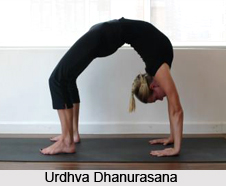 Urdhva Dhanurasana is a cultural asana derived from Dhanurasana, a yoga asana described in several major yoga texts. The revised `urdhva` or upward posture strengthens the abdomen, the spine and the arms and legs.
Urdhva Dhanurasana is a cultural asana derived from Dhanurasana, a yoga asana described in several major yoga texts. The revised `urdhva` or upward posture strengthens the abdomen, the spine and the arms and legs.
Meaning of Urdhva Dhanurasana
Urdhva means Upward, while Dhanu means bow. The body takes the shape of a bow which is about to shoot an arrow upward. This asana is also known as backbend or wheel pose.
Practice of Urdhva Dhanurasana
* Lie supine on the floor. Bend the knees and set the feet on the floor, heels as close to the sitting bones as possible.
* Bend the elbows and spread the palms on the floor beside the head, forearms relatively perpendicular to the floor, fingers pointing toward the shoulders.
* Pressing the inner feet actively into the floor, exhale and push the tailbone up toward the pubis, firming (but not hardening) the buttocks, and lift the buttocks off the floor.
* Keep the thighs and inner feet parallel. Take 2 or 3 breaths. Then firmly press the inner hands into the floor and the shoulder blades against the back and lift up onto the crown of the head.
* Keep the arms parallel. Take 2 or 3 breaths.
* Press the feet and hands into the floor, tailbone and shoulder blades against the back, and with an exhalation, lift the head off the floor and straighten the arms.
* Turn the upper thighs slightly inward and firm the outer thighs. Narrow the hip points and lengthen the tailbone toward the backs of the knees, lifting the pubis toward the navel.
* Turn the upper arms outward but keep the weight on the bases of the index fingers. Spread the shoulder blades across the back and let the head hang, or lift it slightly to look down at the floor.
* Stay in the pose anywhere from 5 to 10 seconds or more, breathing easily. Repeat anywhere from 3 to 10 times.
Once in the pose, lift the heels away from the floor and press the tailbone toward the ceiling. Walk the feet a little closer to the hands. Then, from the height of the tailbone, press the heels into the floor again. This will increase the depth of the backbend.
Effects of Urdhva Dhanurasana
* The asana stretches the chest and lungs
* The arms and wrists, legs, buttocks, abdomen, and spine gets strengthened.
* Stimulates the thyroid and pituitary
* Increases energy and counteracts depression
* Therapeutic for asthma, back pain, infertility, and osteoporosis
Precautions in the practice of Dhanurasana
The asana is to be avoided in case of Back injury, Carpal tunnel syndrome, Diarrhoea, Headache, Heart Diseases and High or low blood pressure.




















